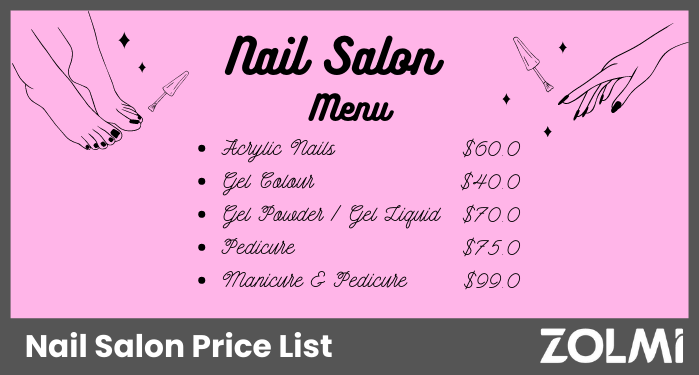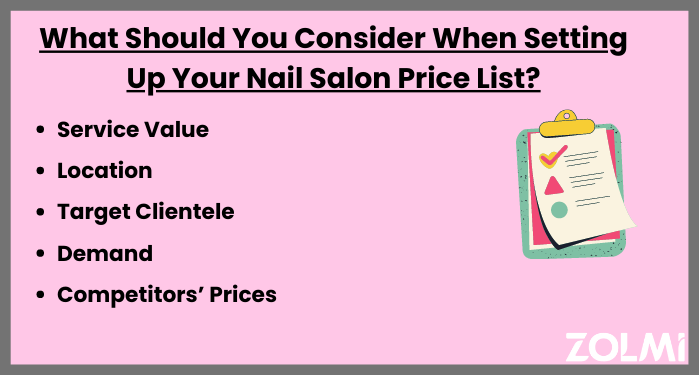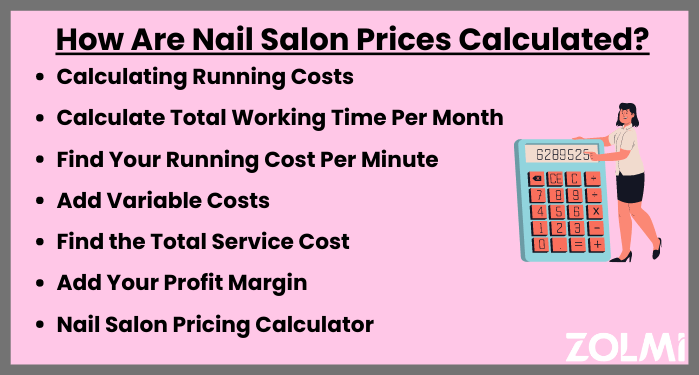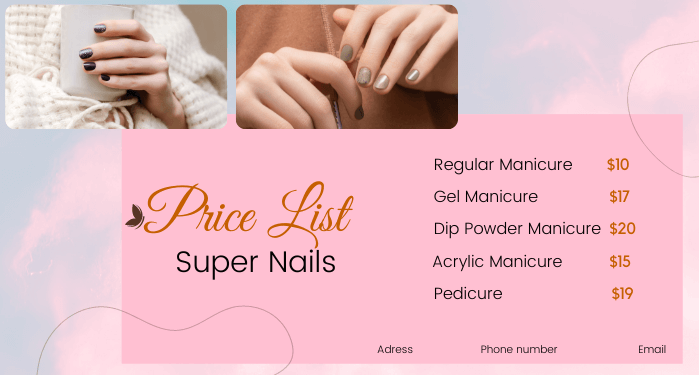How To Build Your Nail Salon Price List in 2024


Creating your nail salon price list and deciding on your pricing strategy is one of the most important things you’ll do when setting up your nail salon. Let’s look closer at how it’s done.
In this article, we’ll go over the basics of creating a nail salon pricing list, including how to start setting it up, some common mistakes to avoid, plus a free template to help you get started.
As you’re deciding how to set prices for your nail salon’s services, you’ll need to consider a couple key things.
Your nail salon’s location and target market will both have a huge impact on the nail services that you offer, as well as what you charge clients for each item.
Some additional things that can have an impact on your prices are what your competition charges/ offers, whether a certain manicure service is in high demand, and the overall value of each item on the menu. Let’s look at all of these a bit closer:
While offering discounts left and right can sound like a tempting way to get clients in the door at first, it’s not a sustainable way to cover your nail salon cost or make a profit. You need to charge more than you spend if you want to make money and stay in business.
Nail salon owners and managers will need to know the Break Even Point or BEP for everything on your menu.
Calculate the typical costs of each item, including supplies, nail technician pay (in terms of time spent), and set your prices to cover these. Whatever you make after this counts as profits.
Next, consider where your nail salon is located. Location can have a big impact on the type of clients you serve, and give you valuable insight into your pricing strategy. Most salons in a busy or upscale urban area can charge a bit more for a standard manicure, for example.
That said, having several competitors nearby will also impact your prices. Do some research online and check out the websites of any nearby nail salons- you can see what services they offer, as well as the going rate for standard manicures and specialty services in your area.
You’ll also want to get to know the average client in your area. Look up the average income online, as this will give you a better idea of how you can set prices, as well as what potential services you can offer.
Are natural nail services in demand among your chosen clientele? What about gel nail polish or french tips? Check out social media and see what’s trending- you can often charge a bit more for in-demand services. Finally, see what your competitors offer and what they’re charging.
And speaking of your competitors, you’ll also need to have an idea of what specialty manicure services they offer, what their price menu looks like, and the clients they target. Check out their websites before making any decisions about your own business.
Unless you’re a luxury nail salon or operating under a prestigious brand, your prices should be set low enough to compete in your local market.
At the same time, avoid undercharging needlessly. If your standard pedicures, manicures or specialty designs are too cheap, customers might either get the impression that they’re low-quality, or they’ll come to expect cheap prices and balk at any future price increases.

Your nail salon’s price strategy, including promotions or loyalty programs, will depend heavily on your long-term business goals and marketing strategy.
You might decide to change it to create more demand for certain services, add-ons or products. The trick is to know when to offer clients discounts and when to raise prices to make profits go up.
Let’s look at some of the most common price strategies and some tips to make them work for you.
Usually employed by nail salon owners trying to bring in more clients, this might be the right strategy for a nail technician who’s setting up shop in a new area. Manicures and pedicures start at a lower price to gain clients, then gradually go up over time.
This can be a good way to get people in the door, but it’s not always the right strategy. After all, some clients might get accustomed to paying lower prices, then be disappointed if the price goes up.
Additionally, you don’t want to undercharge to the point that your manicure and pedicure services aren’t profitable, and you definitely don’t want to be perceived as low-quality.
To use this technique, you need to understand your clients. Figure out what they want and value, then set your prices accordingly.
Once you understand what they want, what they usually avoid, and which manicure services are in demand, you can set your price menu with this in mind.
Often experienced nail salon owners with strong client relationships or those who’ve been in the nail industry for a long time use this technique well.
Use this to simplify your pricing by starting new or deluxe manicure services at a higher price, then gradually lowering it as the novelty wears off.
If a new gel manicure technique, fake jewels or droplet nails are trending, you can maximize profits right now, then decrease prices later as something else comes into fashion.
If your goal is to attract clients who can pay more for premium services, but also bring in people interested in your regular offering, then this might be a good way to go.
Is your brand well-known? Are your nail techs highly experienced with a large social media following? If so, then you may want to consider prestige pricing.
Clients are usually happy to spend more per service if your nail salon is seen as prestigious. Also called “image pricing”, it relies on your brand’s value and reputation.
While you’ll still need to be careful using this method, it can work very well if you do your research. Basically, you set your nail salon’s prices apart from competitors by being slightly more affordable, while also being careful not to undercharge.
Check out what others in your area charge to do nails, and target clients with lower incomes like students, senior citizens and young professionals. You can offer a price-conscious market some pampering without breaking the bank.
Your price list’s structure works with the strategy you’re using and helps define your approach to individual prices on your nail salon’s menu.
Let’s look closer at some common structures for pricing, and see how you can make the most of each one:
This is very straightforward- you charge a single price per manicure or pedicure, without adjusting for time, polish (or other products used) etc. It’s easy for clients and techs to calculate, but not very flexible.
For example, all gel nails would be the same price, no matter the lengths, shape or other designs added. This works well for premium or basic offerings.
Start by charging a basic price for any manicure or pedicure, then use add-ons, upgrades or other extras to increase the amount. Clients like the transparency of the prices, and you incentivize them to spend a bit more.
A simple manicure can be upgraded to a gel manicure, or a full set of acrylic nails, including a pedicure and a hand massage.
Nail salons sometimes do this for complex or intricate, multi-step treatments when you can’t easily price things using your regular menu. Ask customers to “call for more details on prices” if they have these custom or special requests.
You’ll still need a regular menu for standard manicure and pedicure services.
Use this combination to provide customers with fixed prices on your menu, then offer to consult with them for specialized or custom work. If you do specialty nail art, such as aquarium nails or large bridal party bookings, this may be a good option.
This involves discounting a basic service, then making your money through upselling. An example is listing a manicure at a low price, then encouraging your nail techs to upsell more expensive add-ons like a shellac manicure, gel nails or a full set of acrylics.
This can help motivate your team and increase the number of services clients book.
We recommend you to check out our post How to Open a Nail Salon.
I often hear “How much should I charge customers for a manicure/pedicure/etc.?” To answer this we’ll have to start by figuring out how much each item on your menu costs.
Look at every item and divide it by the time it takes (a $45 manicure that takes an hour is $40 divided by 60 minutes = $0.75 a minute). After you’ve got this number for every item, you can move on to the next step.
Your final prices need to cover your running expenses, nail technician salaries, and the products you use.
These are your yearly expenses in total, including rent, taxes, marketing costs, supplies, utilities, business insurance, cleaning, etc.
Nail Salon Running Costs = (Rent + Taxes + Marketing + Supplies + Utilities + Insurance + Cleaning)/ 12 Let’s look at an example:
A nail salon that pays $40,000 a year in rent, $10,000 in taxes, $3,500 in marketing, $8,500 in supplies, $10,000 for utilities, $1,000 for insurance and $3,000 in cleaning fees has a running cost of $76,000, or $6,333 each month.
So, how do you include this in the cost of every gel manicure? Let’s look at how this works.
Now, you can calculate how many hours your business is open each month and multiply this by your available work stations.
If you’re open 10 hours a day, Monday through Saturday, with ten manicure stations, then your Total Monthly Working Time is (10 hours x 24 days a month) x 10 stations = 2,400.
Now, take your nail salon’s running costs per year and divide it by 12 months. Then divide this again by your total monthly working hours, and finally divide this number by 60. You’ve got the running cost per minute.
This is the formula:
Running Cost Per Minute = Running Cost Per Year / 12 / Total Working Time Per Month / 60
Here’s an example:
Running Cost Per Year ($76,000)/ 12 months / Total Monthly Working Time (2,400 hours)/ 60 = $0.04.
This number represents the cost of keeping your business open.
Each product you use would be added. You’ll also calculate every employee’s salary.
Take each staff member’s salary, divide this by their working hours per month, and then divide by 60. This gives you their cost per minute.
For example, a nail tech that makes $2250 a month and works 40 hours a week is calculated as follows:
Team member’s Salary ($2,250) / their Working Hours Per Month (160) / 60 = Staff Cost per Minute of $0.23.
This number breaks down your nail salon’s running cost per minute plus your staff cost per minute, multiplied by your service time. Then, you add your supplies’ cost to it.
The formula is simple:
Service Cost = (Running Cost per Minute + Staff Cost per Minute) x Service Time + Products Used
If we use the numbers from our previous calculations, using an $11 total for the products used in this example, and assuming that a gel manicure with nail art takes 1 hour to perform.
Service Cost = (Running Cost Per Minute ($0.04) + Staff Cost Per Minute ($0.23)) x Service Time (60 mins) + Products Used ($11)= ($27.20).
Finally, you will want to make a profit. Consider your pricing strategy, and remember what we said about the problems with undercharging.
Now, add the margin you want to your final price.
Average profit margins in the beauty industry can be anywhere from 2% to 17%, depending on what you offer and your location.
Here’s the formula:
Service Price = Service Cost x (1 + Margin).
Using nail salon software will make pricing everything easier. This software includes a calculator to help break everything down, along with valuable business insights into the popularity of each service you offer, making it easy to make changes and adjustments later on.
Do not miss our post on Nail Salon Expenses.

Manufacturers often set their prices, but will give you a certain range you change charge within. Check out their websites to see what recommendations they offer nail salons.
Make sure to cover the cost of delivery and storage, too. Depending on the products and your target market, your nail salon’s retail margins should most likely be somewhere between 50 to 100%.
Here are some strategies you can use:
Manufacturers will usually provide a standard price. Retailers will usually sell their products to you at about 50% of this, so that you can make a profit. Of course, this varies from product to product.
You can sell multiple items together for a better price. This helps you to move less popular products, while also making a profit on volume. A great example would be a gel polish, cuticle oil and pumice stone as a gift set.
Customers often like this, but it can be harder to sell these items individually for a higher price, later on.
Grocery stores are famous for this. Basically, you price a popular item cheaply to bring in customers, then convince them to buy some additional items in the same trip.
Start by checking your competitor’s average prices, then set yours a little bit lower to tempt customers into buying from you. Although this can be very effective, it also makes changing your prices later challenging.
In this case, you deliberately charge a premium for items on your price list, giving the impression that these polishes and products are superior and high-end. If you’re operating in an upscale area, this might be the way to go.
Too many custom options and variables can confuse clients and make it hard for your staff, too. Stick to simple, approachable terms and language so that everyone can make a choice without feeling confused about their options.
Stick to discounting just when it’s appropriate (for example on products about to expire, or for seasonal items, etc.). You don’t want to undervalue your services.
Every business has its ups and downs, and the nail industry is no exception. Dropping prices after a slow week or two won’t help, and can actually make it harder to make a profit and gain new clients when you eventually need to raise them again.
Use partial numbers like $19 instead of $20 and avoid decimal places- this makes prices seem smaller and it really does work to convince clients to spend more. It may seem silly at first, but give it a try and you’ll be surprised.
Include any specialized training your team has received (did they take a course on repairing broken acrylics, natural nail care or french manicures, this year) and add this to your yearly expense calculations.
Always be transparent and tell clients the reasons behind any price changes. This will help to build trust and keep your client relationships strong.
Do not miss our post on Nail Salon Business Plan.
Before deciding on a price for each item on your nail salon’s menu, you’ll need to figure out what exactly you want to put on the menu.
Most nail salons include the basics like acrylic nails, gel nails, nail art, manicure and pedicure services, as well as some specialty items like treatments for dry skin on the hands or feet, custom manicures and any other items that you want to offer clients.
Don’t forget to put everything (and the prices) on your nail salon’s website.
To help you get started, we’ve provided a free template that you can use and adjust as needed. Feel free to make any changes to suit your own nail salon’s needs.

Although it might seem like a lot of work at the beginning, planning and setting up your nail salon’s price list is actually a great way to get to know your business and develop a vision for its future success.
This process will help you to get to know every aspect of your business and develop a detailed plan that will make it much easier to make any future decisions. By creating your nail salon price list and adjusting it as needed, you’re setting your business up for future success.
Is it time to rethink your pricing strategy
http://gsl-archive.mit.edu/media/programs/mexico-summer-2015/materials/is_it_time_to_rethink_your_pricing_strategy.pdf
10 Asset Pricing Implications of Equilibrium Business Cycle Models
https://www.degruyter.com/document/doi/10.1515/9780691218052-014/html
A strategic approach to industrial product pricing: The pricing plan
https://www.sciencedirect.com/science/article/pii/S0019850104001208